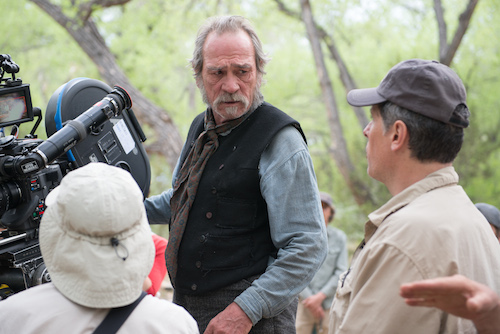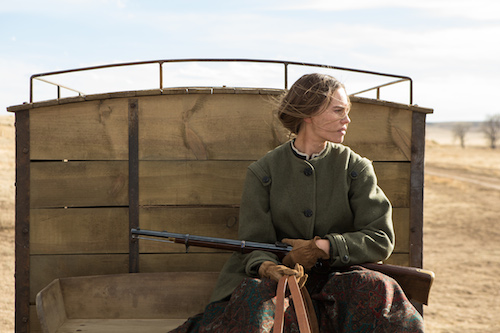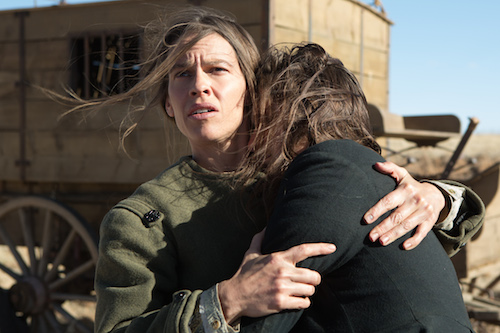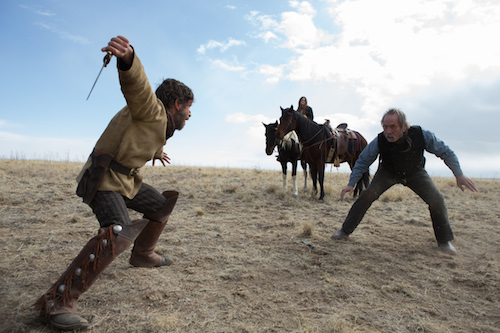Synopsis: When three women living on the edge of the American frontier are driven mad by harsh pioneer life, the task of saving them falls to the pious, independent-minded Mary Bee Cuddy (Hilary Swank). Transporting the women by covered wagon to Iowa, she soon realizes just how daunting the journey will be, and employs a low-life drifter, George Briggs (Tommy Lee Jones), to join her. The unlikely pair and the three women (Grace Gummer, Miranda Otto, Sonja Richter) head east, where a waiting minister and his wife (Meryl Streep) have offered to take the women in. But the group first must traverse the harsh Nebraska Territories marked by stark beauty, psychological peril and constant threat.
Release Date: November 28, 2014 MPAA Rating: PG-13
Genre(s): Western, Drama
Film Review

Production
These days in Hollywood, it’s not enough for some stars to simply act; many bankable actors have turned to writing and directing as well, with big names like George Clooney (The Monuments Men), Ben Affleck (Argo), and Clint Eastwood (Jersey Boys) multitasking their movies. Now, veteran actor Tommy Lee Jones (Lincoln) is getting into the triple-threat business with The Homesman.

The Homesman is set in a township in the Nebraska territories during the western expansion of America in the 19th century. After a particularly bad spell of luck leaves many people and animals in the settlement dead, three women who have been driven crazy during the crisis must be transported to a church in Iowa for help. An unmarried woman named Mary Bee Cuddy (Conviction‘s Hilary Swank) is selected to take the ladies east, and as she prepares for the journey, she comes across a claim jumper named George Briggs (Jones) who is about to be lynched. She saves him, and demands that he accompany her on her trek as repayment. George reluctantly agrees, and they head their wagon towards Iowa, with the insane women safely locked away in back. Mary Bee and George encounter all of the typical western obstacles, including Indians, outlaws, and animals, on their way through the frontier.

Tommy Lee Jones, along with Kieran Fitzgerald (The Ballad of Esequiel Hernandez) and Wesley A. Oliver (Jones’ assistant), adapted the screenplay for The Homesman from a novel by Glendon Swarthout (who also wrote the novels for The Shootist and Where the Boys Are). As far as westerns go, it’s a pretty solid effort. Although it does contain plenty of the tropes and archetypes of the genre, the movie isn’t full of gunfights and horse-rasslin’. At its core, The Homesman is a very human story; the few scenes of action are secondary to the character-driven portions of the script. From the beginning, Mary Bee Cuddy is a lonely character looking for her place in life, and she thinks that transporting the three women east might help her find it. She also believes that George Briggs is the right man to assist her not only with her mission, but with her search for herself. George is the one who has the real character transformation, however, as the time that the pair spends together also has a profound effect on him and his outlook on life.

The Homesman is not without its flaws; the whole thing feels a little padded, with the storyline tending to follow a few threads that don’t go really go anywhere. At a little over two hours, the film could stand to be anywhere between fifteen and thirty minutes shorter without the cutting of any necessary plot points. Sometimes, too much character development weighs the film down, and things that are spoken could be shown in a lot less time. Despite the filler, however, the movie doesn’t ever lose its audience. It’s entertaining enough to hold the interest of even the most casual of western fans, but it’s not a quick and easy watch. Nevertheless, The Homesman is still worth the time.

Acting
It seems as though Tommy Lee Jones used his Hollywood clout to assemble the cast for The Homesman. He and Hilary Swank carry the movie, and they are as great as one would expect from two actors with their experience, but there are a ton of heavyweights in supporting roles. John Lithgow (Love is Strange) makes an appearance as the preacher of the Nebraska settlement. James Spader (Lincoln) plays an unscrupulous frontier hotel proprietor. William Fichtner (Elysium) and Jesse Plemons (“Friday Night Lights”) are both cast as husbands of the insane women. Last, but certainly not least, Meryl Streep has a small role as a reverend’s wife. The big names give somewhat inconsistent performances; Spader and Lithgow do well while Streep seems to phone it in. However, a phone-in performance from Meryl Streep is still better than a stellar one from any other actress, so her presence in The Homesman does makes the film better.


Cinematography
The Homesman was wonderfully shot by cinematographer Rodrigo Prieto (Argo, The Wolf of Wall Street). Prieto’s photography captures the look and feel of the classic westerns without making the film seem dated. Shot in the badlands of New Mexico, The Homesman looks like a true modern revisionist western. The external shots make great use of the sweeping landscape, using wide angle lenses to emphasize the massive expanse of the countryside. Prieto has a distinct way of using motivated light to get an extremely natural look; every light source originates from a logical place, whether it’s a candle, a lantern, a campfire, or some other point. The results are a beautiful-looking film that still remains as gritty and raw as a western should. The Homesman looks great without looking fake.


Score and Soundtrack
Written by Marco Beltrami (The Hurt Locker, 3:10 to Yuma), the musical score to The Homesman is fairly on point for what it needs to be. In addition to the typical cinematic orchestral offerings, the soundtrack is full of authentic sounding music composed for guitar, fiddle, and banjo. It’s a cool mix, letting the viewer know that they’re watching a period movie while managing to not sound outdated. There is one little thing about the music that is distracting. The main theme, which is played over and over ad nauseam throughout the film, is “heavily influenced” by a public domain Christmas carol called “Angels We Have Heard on High” – “heavily influenced” meaning that Beltrami’s score rips the theme off note-for-note. It’s a nitpicky thing, but it’ll be a hard one for those who notice it to get past; you can’t un-hear it. It’s something that only the most attentive of music nerds will pick up on, but there’s no way that Beltrami couldn’t have heard it as he was writing. Again, it’s just a tiny distraction in an otherwise great score.
Cast and Crew
- Director(s): Tommy Lee Jones
- Producer(s):
- Screenwriter(s): Tommy Lee JonesKieran FitzgeraldWesley A. Oliver
- Story:
- Cast: Tommy Lee Jones (George Briggs)Hilary Swank (Mary Bee Cuddy)Grace Gummer (Arabella Sours) Miranda Otto (Theoline Belknap)Sonja Richter (Gro Svendsen)William Fichtner (Vester Belknap)Meryl Streep (Altha Carter)
- Editor(s): Roberto Silvi
- Cinematographer: Rodrigo Prieto
- Production Designer(s):
- Costume Designer:
- Casting Director(s):
- Music Score: Marco Beltrami
- Music Performed By:
- Country Of Origin: USA